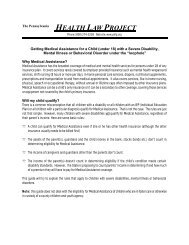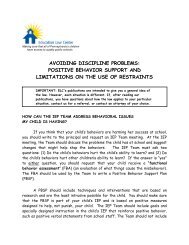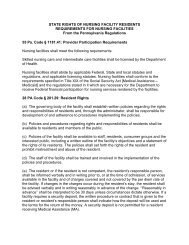Trauma is the Common Denominator, Healing is the Common Goal ...
Trauma is the Common Denominator, Healing is the Common Goal ...
Trauma is the Common Denominator, Healing is the Common Goal ...
- No tags were found...
You also want an ePaper? Increase the reach of your titles
YUMPU automatically turns print PDFs into web optimized ePapers that Google loves.
The American Psychiatric Association’s Diagnostic and Stat<strong>is</strong>tical Manual (DSM-IV) defines a“traumatic event” as one in which a person experiences, witnesses, or <strong>is</strong> confronted with actualor threatened death or serious injury, or threat to <strong>the</strong> physical integrity of oneself or o<strong>the</strong>rs. Aperson’s response to trauma often includes intense fear, helplessness, or sheer horror. 1 <strong>Trauma</strong>can result from experiences that are “private” (e.g. sexual assault, domestic violence, childabuse/neglect, witnessing interpersonal violence) or more “public” (e.g. war, terror<strong>is</strong>m, naturald<strong>is</strong>asters).Medical researchers, sociolog<strong>is</strong>ts, and healthcare professionals increasingly recognize trauma asa significant factor in a wide range of health, behavioral health, and social problems. 2 3 <strong>Trauma</strong>resulting from prolonged or repeated exposures to violent events can be <strong>the</strong> most severe. 4Clearly, different individuals react to trauma in <strong>the</strong>ir own way, depending on <strong>the</strong> nature of andcircumstances surrounding <strong>the</strong>ir traumatic experiences. For example, trauma associated withrepeated childhood physical or sexual abuse can become a central defining character<strong>is</strong>tic to asurvivor’s identity, impacting nearly every aspect of h<strong>is</strong> or her life. Regardless of its cause,trauma <strong>is</strong> a central mental health concern and a “common denominator” for violence and d<strong>is</strong>astervictims.The Human Cost<strong>Trauma</strong> can have severe negative impacts on a person’s physical and emotional state. The mostcommon experiences include flashbacks, emotional numbness and withdrawal, nightmares andinsomnia, mood swings, grief, guilt, d<strong>is</strong>trust, and a lack of physical or sexual intimacy. <strong>Trauma</strong>has been linked to hallucinations and delusions, depression, suicidal tendencies, chronic anxietyand fatigue, hostility, hypersensitivity, eating d<strong>is</strong>orders such as anorexia or obesity, and o<strong>the</strong>robsessive behaviors. 5Victims are at a much higher r<strong>is</strong>k for co-occurring mental health d<strong>is</strong>orders and substance abuse,violence victimization and perpetration, self-injury, and a host of o<strong>the</strong>r coping mechan<strong>is</strong>mswhich <strong>the</strong>mselves have devastating human, social, and economic costs. <strong>Trauma</strong> has been linkedto social, emotional, and cognitive impairments, d<strong>is</strong>ease, d<strong>is</strong>ability, serious social problems, andpremature death. 6In fact, between 51 percent and 98 percent of public mental health clients diagnosed with severemental illness have trauma h<strong>is</strong>tories, 7 and prevalence rates within substance abuse treatmentprograms and o<strong>the</strong>r social services are similar. 8 In children, trauma may be incorrectlydiagnosed as depression, attention deficit hyperactivity d<strong>is</strong>order (ADHD), oppositional defiantd<strong>is</strong>order (ODD), conduct d<strong>is</strong>order, generalized anxiety d<strong>is</strong>order, separation anxiety d<strong>is</strong>order, andreactive attachment d<strong>is</strong>order. 9 10 Adults also encounter similar m<strong>is</strong>diagnos<strong>is</strong> and obstacles inhaving <strong>the</strong>ir trauma experiences understood and addressed.The Adverse Childhood Experiences (ACE) study, which examined <strong>the</strong> health and social effectsof traumatic childhood experiences over <strong>the</strong> lifespan of 18,000 participants, demonstrated thattrauma <strong>is</strong> far more prevalent than previously recognized, that <strong>the</strong> impacts of trauma arecumulative, and that unaddressed trauma underlies a wide range of problems. Chronic medicalconditions such as heart d<strong>is</strong>ease, cancer, lung and liver d<strong>is</strong>ease, skeletal fractures, and HIV-AIDSP.O. Box 2516, Rockville, MD 20847-2516 ● p: 301-846-9110 ● info@witnessjustice.org ● www.witnessjustice.org
















